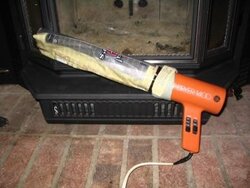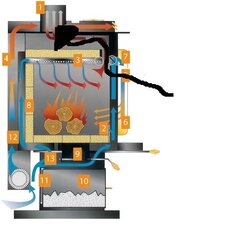Martin Strand III
New Member
Trying to make good on a bad set up is tough.
One problem which has not been addressed directly is to correct, or minimize, your DEPRESSURIZED basement.
This is a common problem with basement wood burners.
Opening windows adds to the problem (the 'stack effect') of depressurizing your basement since your whole house acts as a chimney;i.e.,
air flows from basement to higher levels. Upper levels thus develop higher pressure than lower levels.
I would try pressurizing your basement by placing a good sized fan on the main level floor directed down the stairs to the basement.
This will force cooler main floor air downstairs increasing the pressure in the basement, somewhat. Maybe just enough.
Close basement doors and windows to help maintainer a higher pressure (more Pascals).
Make sure any utility fans for H/W heater, bathroom exhausts, kitchen exhaust fans, etc are OFF on all levels of the house.
Light paper and fine kindling in the firebox with your chimney damper open. Keep the door open slightly.
You might be surprised at the results...
Aye,
Marty
One problem which has not been addressed directly is to correct, or minimize, your DEPRESSURIZED basement.
This is a common problem with basement wood burners.
Opening windows adds to the problem (the 'stack effect') of depressurizing your basement since your whole house acts as a chimney;i.e.,
air flows from basement to higher levels. Upper levels thus develop higher pressure than lower levels.
I would try pressurizing your basement by placing a good sized fan on the main level floor directed down the stairs to the basement.
This will force cooler main floor air downstairs increasing the pressure in the basement, somewhat. Maybe just enough.
Close basement doors and windows to help maintainer a higher pressure (more Pascals).
Make sure any utility fans for H/W heater, bathroom exhausts, kitchen exhaust fans, etc are OFF on all levels of the house.
Light paper and fine kindling in the firebox with your chimney damper open. Keep the door open slightly.
You might be surprised at the results...
Aye,
Marty


 haha.
haha.

 ), duct tape to hairdryer, then kinda slip it around the baffles and up the flue.
), duct tape to hairdryer, then kinda slip it around the baffles and up the flue.